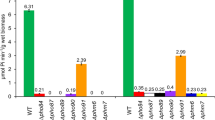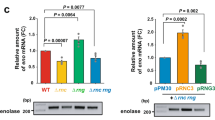Summary
TheNPR1 gene ofSaccharomyces cerevisiae plays a central role in controlling permease activity; its product is required to promote the activity of at least six distinct transport systems for nitrogenous nutrients under conditions of nitrogen catabolite derepression. We report here the nucleotide sequence of the clonedNPR1 gene. The predicted amino acid sequence indicates thatNPR1 encodes a protein of 86 kDa which appears to be organized into two distinct structural domains. The amino-terminal domain of NPR1 (residues 1 to 440) contains 26% serine residues and several regions strongly enriched for PEST residues suggesting a short half-life for the NPR1 protein. The carboxy-terminal region of NPR1 contains consensus sequences characteristic of the catalytic domains of protein kinases. Therefore, NPR1-dependent positive control of nitrogen transport systems most likely involves protein phosphorylation. Northern analysis indicates that the absence of general amino acid permease (GAP1) activity innpr1 mutants is not due to reduction in transcription or messenger stability. Hence, the NPR1 protein probably acts at the post-transcriptional level. Proteins that may serve as substrates for phosphorylation are discussed.
Similar content being viewed by others
References
Béchet J, Grenson M, Wiame J-M (1970) Mutation affecting the repressibility of arginine biosynthetic enzymes inSaccharomyces cerevisiae. Eur J Biochem 12:31–39
Bennetzen JH, Hall BD (1982) Codon selection in yeast. J Biol Chem 257:3026–3031
Celenza JL, Carlson M (1986) A yeast gene that is essential for release from glucose repression encodes a protein kinase. Science 233:1175–1180
Dubois E, Grenson M (1979) Methylamine/ammonia uptake systems inSaccharomyces cerevisiae. Mol Gen Genet 175:67–76
Garnier J, Osguthorpe DJ, Robson B (1978) Analysis of the accuracy and implications of simple methods for predicting the secondary structure of globular proteins. J Mol Biol 120:97–120
Grenson M (1969) The utilization of exogenous pyrimidines and the recycling of uridine-5′-phosphate derivatives inSaccharomyces cerevisiae, as studied by means of mutants affected in pyrimidine uptake and metabolism. Eur J Biochem 11:249–260
Grenson M (1983a) Inactivation-reactivation process and repression of permease formation regulate several ammonia-sensitive permeases in the yeastSaccharomyces cerevisiae. Eur J Biochem 133:135–139
Grenson M (1983b) Study of the positive control of the general amino acid permease and other ammonia-sensitive uptake systems by the product of theNPR1 gene in the yeastSaccharomyces cerevisiae. Eur J Biochem 133:141–144
Grenson M, Acheroy B (1982) Mutations affecting the activity and the regulation of the general amino-acid permease ofSaccharomyces cerevisiae. Mol Gen Genet 188:261–265
Grenson M, Dubois E (1982) Pleiotropic deficiency in nitrogenuptake systems and derepression of nitrogen-catabolic enzymes in nprl mutants ofSaccharomyces cerevisiae. Eur J Biochem 121:643–647
Hamilton R, Watanabe CK, de Boer HA (1987) Compilation and comparison of the sequence context around AUG start codons inSaccharomyces cerevisiae mRNAs. Nucleic Acids Res 15:3581–3593
Hanks SH, Quinn AM, Hunter T (1988) The protein kinase family: conserved features and deduced phylogeny of the catalytic domains. Science 241:42–52
Higgins DG, Sharp PM (1988) Clustal: a package for performing multiple sequence alignments on a microcomputer. Gene 73:237–244
Jacobs P, Jauniaux J-C, Grenson M (1980) Acis-dominant regulatory mutation linked to theargB-argC cluster inSaccharomyces cerevisiae. J Mol Biol 139:691–704
Jauniaux J-C, De Baerdemaeker M (1988) Ty transposon mutagenesis as a tool for gene cloning inSaccharomyces cerevisiae: isolation of the general amino-acid permease GAP1 gene. Arch Int Physiol Biochim 96:45
Jauniaux J-C, Grenson M (1990)GAP1, the general amino acid permease gene ofSaccharomyces cerevisiae: nucleotide sequence, protein homology with the other baker's yeast amino acid permeases, and nitrogen catabolite repression. Eur J Biochem (in press)
Jauniaux J-C, Dubois E, Vissers S, Crabeel M, Wiame JM (1982) Molecular cloning, DNA structure and RNA analysis of the arginase gene inSaccharomyces cerevisiae. A study ofcis-dominant regulatory mutations. EMBO J 1:1125–1131
Jauniaux J-C, Vandenbol M, Vissers S, Broman K, Grenson M (1987) Nitrogen catabolite regulation of proline permease inSaccharomyces cerevisiae. Cloning of thePUT4 gene and study of PUT4 RNA levels in wild type and mutants strains. Eur J Biochem 164:601–606
Kamps MP, Sefton M (1986) Neither arginine nor histidine can carry out the function of lysine-295 in the ATP binding site of p60src. Mol Cell Biol 6:751
Lorincz AT, Reed SI (1984) Primary structure homology between the product of yeast cell division control gene CDC28 and vertebrate oncogenes. Nature 307:183–185
Magasanik B, Neidhardt FC (1987) Regulation of carbon and nitrogen utilization. In: Neidhardt FC (ed)Escherichia coli andSalmonella typhimurium. Cellular biology. American Society for Microbiology, Washington, DC, pp 1318–1325
Maniatis T, Fritsch EF, Sambrook J (1982) Molecular cloning. A laboratory manual. Cold Spring Harbor Laboratory, Cold Spring Harbor, New York
Messing J, Vieira J (1982) A new pair of M13 vectors for selecting either DNA strand of double-digest restriction fragments. Gene 19:269–276
Pearson WR, Lipman DJ (1988) Improved tools for biological sequence comparison. Proc Natl Acad Sci USA 85:2444–2448
Pikielny CW, Teem JL, Rosbach M (1983) Evidence for the biochemical role of an internal sequence in yeast nuclear mRNA introns: implications for U1 RNA and metazoan mRNA splicing. Cell 34:395–403
Queen C, Korn LJ (1984) A comprehensive sequence analysis program for the IBM personal computer. Nucleic Acids Res 12:581–599
Rogers S, Wells R, Rechsteiner M (1986) Amino acid sequences common to rapidly degraded proteins: the PEST hypothesis. Science 234:365–369
Rossie S, Catterall WA (1987) Regulation of ionic channels. In: Boyer PD, Krebs EG (eds) The enzymes. Control by phosphorylation. Academic Press, Inc. Orlando, pp 335–359
Russell P, Nurse P (1987) Negative regulation of mitosis byWEE1 +, a gene encoding a protein kinase homolog. Cell 49:559–567
Sanger F, Nicklen S, Coulson AR (1977) DNA sequencing with chain-terminating inhibitors. Proc Natl Acad Sci USA 74:5463–5467
Shoji S, Permelee DC, Wade RD, Kumar S, Ericsson LH, Walsh KA, Neurath H, Lonh GL, Demaille JG, Fischer EH, Titani K (1981) Complete amino acid sequence of the catalytic subunit of bovine cardiac cyclic AMP-dependent protein kinase. Proc Natl Acad Sci USA 78:848–851
Sternberg MJE, Taylor WR (1984) Modelling the ATP-binding site of oncogene products, the epidermal growth factor or receptor and related proteins. FEBS Lett 175:385
Takeya T, Hanafusa H (1983) Structure and sequence of the cellular gene homologous to the RSV src gene and mechanism for generation of transforming virus. Cell 32:881–890
Vandenbol M, Grenson M (1988) The nitrogen permease regulatory geneNPR1 ofSaccharomyces cerevisiae encodes a putative protein kinase. Arch Int Physiol Biochim 96: B62
Vandenbol M, Jauniaux J-C, Vissers S, Grenson M (1987) Isolation of theNPR1 gene responsible for the reactivation of ammonia-sensitive amino acid permeases inSaccharomyces cerevisiae: RNA analysis and gene dosage effects. Eur J Biochem 164:607–612
Wiame J-M, Grenson M, Arst Jr HN (1985) Nitrogen catabolite repression in fungi. Adv Microb Physiol 26:1–87
Zaret KS, Sherman F (1982) DNA sequence required for efficient transcription in yeast. Cell 28:563–573
Author information
Authors and Affiliations
Additional information
Communicated by W. Gajewski
Rights and permissions
About this article
Cite this article
Vandenbol, M., Jauniaux, JC. & Grenson, M. TheSaccharomyces cerevisiae NPR1 gene required for the activity of ammonia-sensitive amino acid permeases encodes a protein kinase homologue. Mol Gen Genet 222, 393–399 (1990). https://doi.org/10.1007/BF00633845
Received:
Issue Date:
DOI: https://doi.org/10.1007/BF00633845




